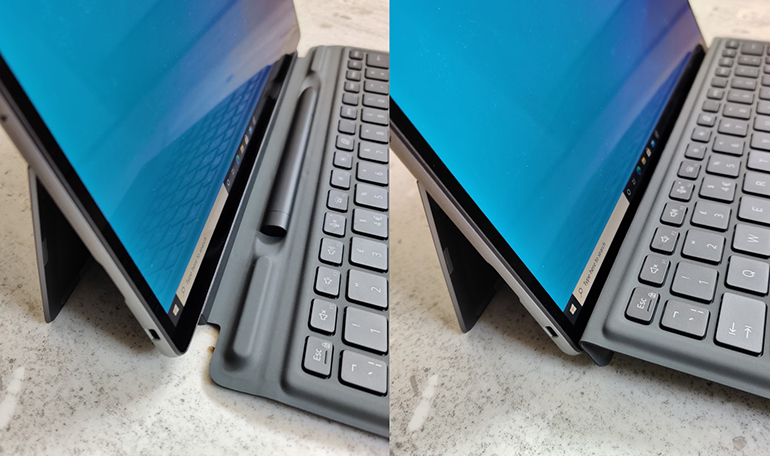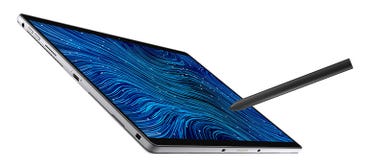Dell Latitude 7320 Detachable review: A worthy Surface Pro alternative Review | ZDNet
Dell’s 2-in-1 laptops are usually 360-degree screen-rotating convertibles, rather than tablets with add-on keyboards. This makes Dell’s new 13-inch Latitude 7320 Detachable a rare beast. That might be surprising given that the ability to leave the keyboard aside when it’s not needed may be an attractive option for mobile professionals. But if content creation is as important as consumption, detachable keyboards can leave something to be desired: they can be flimsy, for example, and a tablet section propped up by a kickstand isn’t comfortable — or even feasible — to use on your lap.
With specifications and a price tag to match a higher-end conventional laptop, the question is, can the Latitude 7320 Detachable do duty as your primary device?
The 13-inch Dell Latitude 7320 Detachable runs on 11th-generation Core i5 or i7 processors with up to 16GB of RAM and 512GB of SSD storage. Mobile broadband is available as an option.
Image: Sandra Vogel / ZDNet
The obvious competitor for the Latitude 7320 Detachable is Microsoft’s Surface Pro, and the Surface Pro 7+ for Business in particular. Just like the Surface Pro, the Latitude 7320 Detachable is more about the tablet than the keyboard, not least because the tablet sits in a solid chassis, while the keyboard is housed in a less sturdy unit with flexible plastic edging. Although I couldn’t bend or flex the keyboard in my hands, it clearly doesn’t have the level of protection provided by a conventional laptop chassis. A protective sleeve for both the tablet and the keyboard might be a good idea.
The tablet measures 288.4mm wide by 207.9mm deep by 8.44mm thick, and weighs 789g. The keyboard (284.2mm x 215.6mm x 5.1mm) adds extra bulk and another 351.4g to the weight. Dell also bundles its Active Pen, which charges when sat in a sunken space on the keyboard (Dell says it will reach 100% in five minutes). I prefer this location to a magnetic attachment on the side of a tablet: the pen can be left in place here long term, so it doesn’t get left behind when you pack up to go on your travels. The pen is flattened rather than circular, so it will sit safely in its housing. This shape has no adverse effect on usability.

Dell’s Active Pen has a home in the detachable keyboard, where it charges wirelessly; the stylus housing is hidden when the keyboard is raised into its more ergonomic typing position (above, right).
Images: Sandra Vogel / ZDNet
As with all detachables, the Latitude 7320 needs a bit more desk space than a conventional laptop, in order to accommodate the kickstand on the back of the tablet. This holds the screen securely at any angle and I had absolute confidence in it. However, it only functions in landscape mode. If you want to prop the tablet up in portrait mode, you’ll have to get hold of a separate stand, and if you want to type with it in this orientation, you’ll need a separate keyboard too.
The Latitude 7320’s 13-inch screen sits in bezels that are wider than the InfinityEdge screens on many Dell laptops, as space is needed to hold the device when working in tablet mode. As a result, the screen to body ratio is a moderate 84%. The FHD+ (1,920 x 1,280, 177.5ppi, 3:2) touch screen delivers up to 500 nits of brightness, which is enough to make it usable outdoors as well as inside. The resolution is arguably a little low if you’re looking for top-notch crispness, but it’s fine for everyday working.
Sound comes from a pair of speakers in the tablet’s short edges. These are fine if used for video calling or talk radio, and there’s plenty of volume, but playing music through them is disappointing due to their lack of bass.
The keyboard and tablet hinge together via a strong magnet, and a fold on the keyboard section can be used to raise the keyboard to a more comfortable typing angle. However, this hides the stylus housing, so you either have to remove the stylus before raising the keyboard or wrench the keyboard flat to access it.
The touchpad is relatively small but responsive, while the keyboard action is mostly fine. There’s not much travel, and typing is accompanied by a dull, hollow sound. I was happy enough with the keyboard, and managed to touch-type at my normal speed. However, there is some flex in the keyboard when it’s raised up at an angle, and even as a light-touch typist I found this annoying. Heavier-handed typists may find the effect even more noticeable.

The Latitude 7320 Detachable in laptop mode, with keyboard attached and kickstand engaged.
Image: Dell
The Latitude 7320 Detachable has just two USB-C Thunderbolt 4 ports, one on each of the tablet’s short edges, so users with USB-A peripherals will need an adapter. The left edge houses two volume buttons and a 3.5mm headset jack, while the right edge has a SIM slot for the optional mobile broadband. There’s a rear-facing 8MP camera on the back of the tablet and my review unit included a smart card reader and NFC touchpoint.
The 5MP front-facing webcam has IR and a proximity sensor — a combo that makes for seamless Windows Hello-based login. There’s a fingerprint sensor built into the tablet, too.
SEE: Office 365: A guide for tech and business leaders (free PDF) (TechRepublic)
The default £1,475.72 (ex. VAT) configuration I reviewed can be tweaked in various ways — dropping the smart card, NFC and physical SIM, and adding eSIM support, for example. My review unit ran on an 11th-generation Intel Core i5-1140G7 processor with 16GB of RAM, a 256GB PCIe NVMe SSD and Intel Iris Xe Graphics. You can double or halve the SSD size, or move to a Core i7 processor.
There isn’t a great deal of space in the tablet to fit a battery, and the installed two-cell 40Wh battery didn’t stand up to a huge amount of punishment. My usual test of writing into web apps, browsing, and listening to streamed music is a relatively lightweight process. Even so, after a three-hour session starting with a full charge, the battery dropped to 43%, suggesting battery life of around 5.5 hours. If you want a full day’s work from the Latitude 7320 Detachable, you’ll likely need access to mains power at some point.
Dell says its ExpressCharge can take the battery from 0% to 80% in an hour, although you need to be powered down to achieve this. When I spotted the battery at 32% I plugged in and continued working, after which I got to 44% in 15 minutes, 57% in 30 minutes and 69% in 45 minutes.

Image: Dell
Conclusions
The Dell Latitude 7320 Detachable is a neat and capable 13-inch 2-in-1 that provides strong competition for Microsoft’s business-focussed 12.3-inch Surface Pro 7+. Dell delivers a good set of features, including an 11th-generation Core processor, a smart card reader and optional mobile broadband with SIM or eSIM support among the highlights. I’m less impressed with the speakers and the battery life though.
The default Latitude 7320 Detachable configuration in the UK (Core i5, Windows 10 Pro, 16GB RAM, 256GB SSD, Wi-Fi only, keyboard and pen included) costs £1,475.72 (ex. VAT) or £1,766.40 (inc. VAT), or $1,992.75 in the US. That’s on a par — in the UK at least — with an equivalent Surface Pro 7+ configuration with a Type Cover keyboard and Surface Pen, which comes in at £1,728.98 (inc. VAT) or $1,759.97 in the US. Both are expensive devices, though.
Microsoft has dominated the business-grade ‘tablet-first’ 2-in-1 market for a long time with its Surface Pro range, but Dell and Lenovo, with the ThinkPad X12 Detachable, are now providing excellent alternatives.
RECENT AND RELATED CONTENT
Dell Latitude 9420 review: A sleek 14-inch ultraportable with versatile 2-in-1 design
Surface Pro 7+ for Business: Here’s what makes it different
Chip shortage will lead to higher PC prices as Dell, HP, and Lenovo pass on higher costs
Dell Technologies rides PC sales surge to strong Q1
Best Windows 10 laptop 2021: Top notebooks compared
Read more reviews
For all the latest Technology News Click Here
For the latest news and updates, follow us on Google News.
